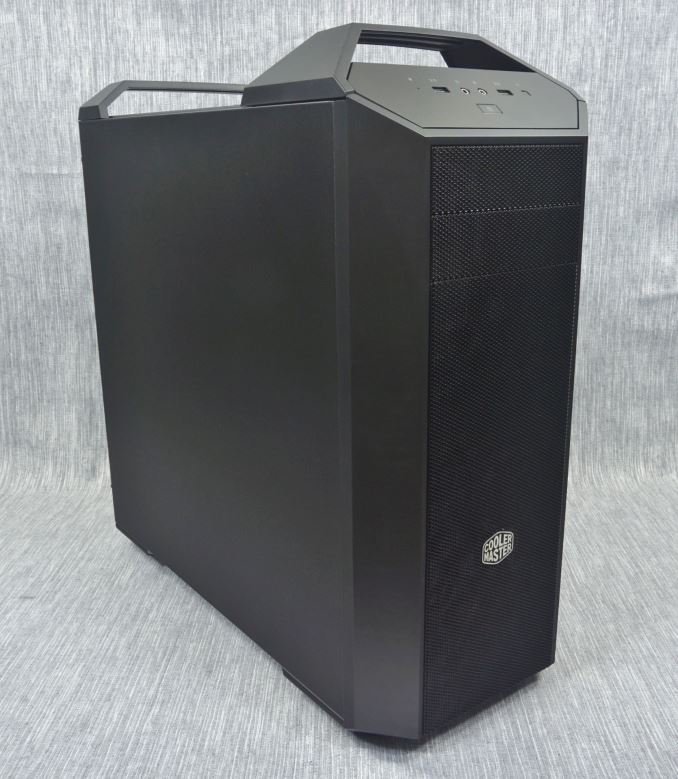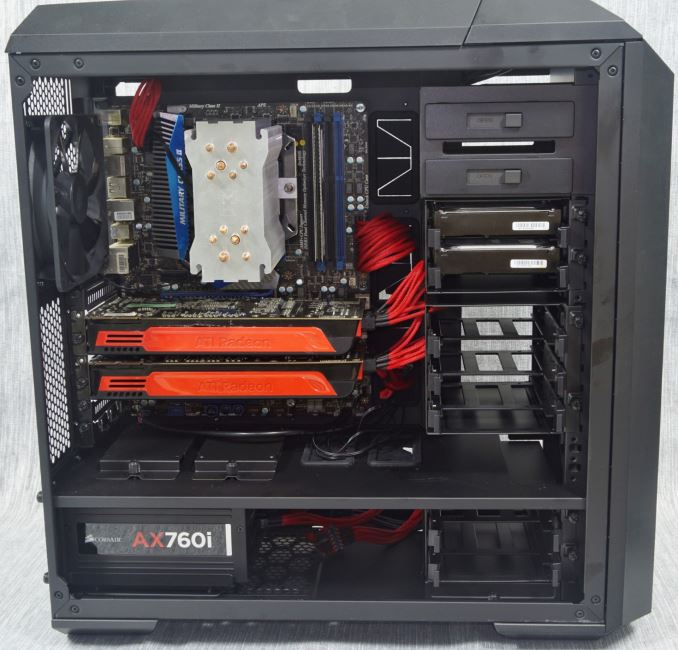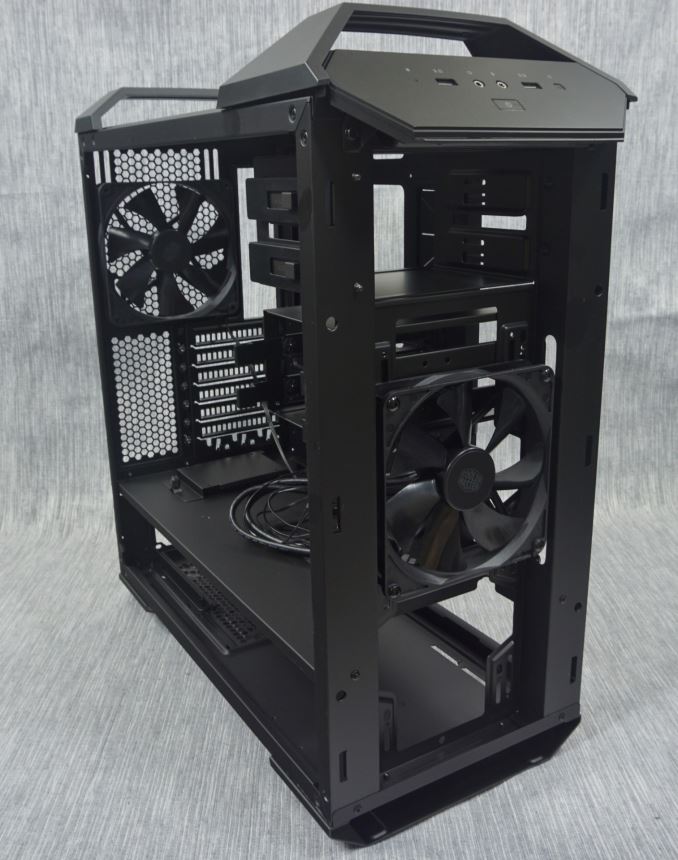The Cooler Master MasterCase 5 Review
by E. Fylladitakis on August 27, 2015 9:00 AM EST- Posted in
- Cases/Cooling/PSUs
- Cooler Master
- mid-tower
- Case
- Freeform
Conclusion
Cooler Master's aspiration to design a modular computer case was definitely not small or simple. As a concept, the design of an upgradable and modifiable case existed for many years now but there were very few attempts on actually designing and retailing one. Cooler Master made many of these attempts, with their first notable attempt probably being the first generation Stacker ten years ago, a case with a rotatable motherboard tray that was both ATX and BTX compatible. However, the company is making very bold claims with the MasterCase 5, stating that it "offers absolute control over how your case looks and functions".
Unfortunately, that was not our experience. The MasterCase 5 is not much more than a typical Midi-ATX tower case, at least not with the number of extras available today. Absolute control over a case's appearance definitely implies much more than just a windowed side panel and a top cover, both of which items are factory options of the MasterCase Pro 5 anyway. Besides, the MasterCase Pro 5 retails for $140 incl. shipping. The windowed side panel costs $25 and the top cover $17, while the MasterCase Pro 5 also has an extra 140 mm intake fan and a second HDD cage installed as well. Even if you just need to install more than two 3.5" drives, purchasing the MasterCase Pro 5 instead is a better option than getting the MasterCase 5 and an extra HDD cage. Technically, the modularity of the stock MasterCase 5 is limited to the movement of the single HDD cage up and down across the faceplate, assuming that there is no long graphics card or liquid cooling radiator to block it.
On the contrary, the average size and the chassis design of the MasterCase 5 seem to impede modularity, not help it. The case is not large enough to house large components without interfering with something else. For example, a liquid cooling radiator at the front will block the installation of HDD cages and it is not possible to install it at the top without the extra top cover. Even though all of the drive cages are removable, the motherboard's tray or the floor separating the system area from the PSU compartment cannot be removed. These are more than just minor limitations of the design. Unless the trend picks up, with more products and accessories supporting Cooler Master's "Freeform" design, those who hoped for a truly modular case will soon be greatly disappointed. However, this could drastically change if Cooler Master introduces more cases based on the "Freeform" modular design, especially if the accessories and certain parts are interchangeable between them.
Still, not everything revolves around the "Freeform" design. As far as functionality and quality go, MasterCase 5 can still hold its own as a good Midi-ATX tower case. Aesthetics are a subjective factor but we believe that Cooler Master did a fine job addressing the MasterCase 5's intended target group. The elegant design and all-black color create an attractive but not extravagant appearance for today's modern environments. It is not complex enough to stand out too much in minimalistic office/work environments either. Some people will definitely find it too much for use in a living room though. As far as quality goes, the MasterCase 5 is well made. We found no significant structural issues or flaws. Cooler Master designed a strong chassis that will not easily bend or twist and used high quality plastic for the top and front covers. Despite the great number of holes and openings, there are no sharp edges or corners throughout the case. The simplicity of the nylon dust filters may be troubling in terms of effectiveness but that type of filter also tends to last for a lifetime without issues. Cooler Master definitely designed the MasterCase 5 with longevity in mind.
Financially, the existence of the standard MasterCase 5 version is not very reasonable. Even if the side panel is unnecessary, the top cover should be a stock option for cases of this range. Without it, the installation of a liquid cooling radiator is limited to the front of the case, reducing the clearance for graphics cards and blocking the installation of HDD cages. Cooler Master is also offering the MasterCase Pro 5, which is essentially the same cage with the side and top panels, an extra three drive cage and one more 140 mm cooling fan preinstalled. With the MasterCase Pro 5 retailing for $140 incl. shipping, the $110 incl. shipping retail price of the MasterCase 5 does not seem like much of a deal. If we suppose that the user would be happy with the stock options of the MasterCase 5, it does not really offer more than just another Midi-ATX tower case. There are literally dozens of other very good Midi-ATX cases around its price tag, placing very strong competition on Cooler Master's newest design.
In our humble opinion, Cooler Master should begin by applying the "Freeform" modular design to a larger, stronger case. Where virtually the only practical option of the MasterCase 5 is the choice between extra HDDs and long cards or a liquid cooling radiator, a larger case would provide room for more options and reduce overlap between them. It is very likely that the designers would end up with a rather expensive product, yet it would be targeting advanced enthusiasts, a market group that is frequently eager to pay the premium price for high performance equipment. The MasterCase 5 is well made and functional but not as versatile as the company suggests it is, and it is targeted at users who strongly consider the best value they can get for their money. With such a hefty price tag, it will be difficult for Cooler Master to convince the mainstream user that the MasterCase 5 is really worth it, unless they are prepared to empower Cooler Master's slogan and truly customize the design with a dremel and a unique color scheme.
In summary, the MasterCase 5 is a mechanically good case but it is rather overpriced for what it can actually do. We have no reason not to recommend it for its quality or performance, but it is an expensive design and competition will be more than fierce. When the trend picks up, with more cases and accessories released, perhaps that will change. However, for the time being, the MasterCase 5 is not much more than just a good Midi-ATX tower amongst the dozens of other products available, but implements a step forward in the concept nonetheless. From the customization perspective, a 'MasterCase 7' or 'MasterCase 9' might offer a larger opportunity if Cooler Master has those on the cards for the future. Still, if you are excited about the (partial) modularity of the MasterCase 5 or you simply like its design a lot, we strongly suggest that you should go straight for the Pro version.













32 Comments
View All Comments
winterlord - Thursday, August 27, 2015 - link
how much does it weigh?BrokenCrayons - Thursday, August 27, 2015 - link
From the second page of the review - "It also tipped our scale at 10.4 kg, making it a fairly heavy case for the size."nmm - Thursday, August 27, 2015 - link
From where I'm sitting their "modular" approach looks a bit like they're just selling you a case that doesn't come with all the parts. I'm pretty sure my Fall Sky Lake build is still going into a Fractal Design Define R5 (or perhaps a Define Mini if they ever get around to updating it... and if anyone ever releases a micro ATX board that isn't riddled with useless SATA Express ports).freeskier93 - Thursday, August 27, 2015 - link
I'm sure the designers/engineers know very well what countersinking is, so well they also know countersinking into such thin sheet metal is not a good method. Even at a large 130* countersink there would be very little surface contact between the sheet and fastener.E.Fyll - Thursday, August 27, 2015 - link
The openings are made for screws with countersunk heads and the thin sheet metal, even with fans attached, has no weight that would cause problems with such screws, even if the contact surface is small.Besides, the thin sheet sits on the metallic frame and gravity does not go up.
freeskier93 - Thursday, August 27, 2015 - link
Taking a closer look at the pictures it looks they are dimpled, which would be the better method, so it is odd they used a big cheese head screw.'nar - Thursday, August 27, 2015 - link
I have to agree with the reviewer, and here are some reasons why. You can expand a case in any direction with optional components, except the rear panel with the motherboard connections. The top can not only have a radiator, but also padded external drive bays, Flash drive USB ports, additional buttons, fans controls, lighting controls, and such. The front can have a metal frame that screws to the existing frame to extend the case with new drive bays, radiator options, a closing door, thicker sound insulation and filtration. The bottom could have an additional power supply for high-power rigs and more drive bays. And the side panels could come with different window shapes and embedded lighting options, sleeves for the motherboard manual, hangars for headphones, or art-deco. This would all be designed to bolt onto a standard core frame size, so your core can be swapped for different configurations as well.Sounds good, but I have not made any CAD drawings to check any sizes or clearances to see if any of this would actually fit together in any aesthetically pleasing way. But I do desire a case with good sound absorption and air-filtration, water cooling, and hot-swap hard drive bays.
Taurus229 - Thursday, August 27, 2015 - link
If I were to spend $110.00 on a case I would want it to have what I feel is important to me, and not have to consider buying accessories to upgrade. Either it has it or it doesn't. It's that simple.sonny73n - Friday, August 28, 2015 - link
All PC cases lack of something very important to me - dust filter. I'm talking about real air filter, the one you have in your car, not some foam. Foam air filters can't block fine dust which in about a year will build up a nasty layer of dust on everything, especially on the fans and CPU heatsink. I had to modify my Antec case with 3 fans sucking air in from the front, behind a modified washable car air filter, and 3 blowing air out on top, side and back. It's been almost 2 years and no dust. No more worries of system overheats and annual cleanup caused by dust buildup on my OCed system. Yay ;-)marvdmartian - Friday, August 28, 2015 - link
Not sure....what exactly is the reason for handles on top of a case this size? Is it just for the coolness design factor? Haven't seen a LAN party in years, but I doubt people are lugging around cases like this much, any more.While it might have some nice features, for me, at least, the price point is too high, for what it's offering.